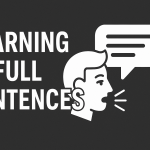Will artificial intelligence make learning languages child’s play? Maybe it won’t even be needed at all, replaced by a tiny chip implanted in the wrist that will make us understand all the languages of the world? Or smart glasses that will translate everything we see and hear in real time?
Imagine a world where you could learn any language in the blink of an eye. Without painstakingly buying into complicated grammatical rules and frustrating mistakes. A world where an intelligent language assistant accompanies you every step of the way, correcting mistakes, translating intricate texts and motivating you to keep learning. Sounds like a utopia?
For now, such a vision is science fiction. However, AI is entering the field of language education, diversifying the way languages are learned. That’s why in this article we’ll take a closer look at this fascinating phenomenon and discover how AI can already help you achieve your linguistic goals and practice the skills you’ve acquired. We will also point out what to watch out for when using these solutions.
Why learn languages when there is AI?
It’s so easy to use Google Translate – just point the camera lens at the text and you’ll instantly see the foreign-language text written in your familiar native language! However, what if you want to ask something? You can use the real-time translation function! It’s that simple. However, the situation gets complicated if you want to really talk to someone, rather than order a meal at a restaurant or buy a ticket.
Knowing English and other languages opens up a plethora of opportunities, in both our personal and professional lives. It allows us to travel the world without language barriers, learn about new cultures, build relationships with people from different corners of the globe and get our dream job.
Until recently, the main barrier to technology-assisted language learning was the lack of adequate interaction. Listening to an audio course, you could learn the correct pronunciation, but no one corrected your speech. By solving interactive quizzes with grammar tasks, you learned the intricacies of foreign speech, but you did not practice it on sentences used in real-life situations. This particular “passivity” impeding language learning is confirmed by the story of a child, Jim, raised by deaf parents.
Jim’s parents tried to care for him as best they could, so, unable to talk to him, they turned on the TV for him. Despite the attentive care, Jim’s early language development was severely hampered by the lack of interactive communication. Although Jim knew individual words, he learned incorrect speech patterns and made many grammatical errors that would never be made by children who learn language by speaking and imitating adults. His progress only accelerated significantly when he began to talk regularly with a person who answered his questions.
Thanks to artificial intelligence, tremendous progress has been made in certain areas of language learning, as the chat can not only present pronunciation or spelling, but it can actively answer our questions – by either writing or speaking. It’s an interesting exercise, but we know from Jim’s story that it’s not enough to develop language.
But that’s not all.
It’s also worth remembering that learning is not only about interaction, but also, and perhaps most importantly, repetition and memorization of material. Without repetition, we will not consolidate the knowledge, and the conversation itself will only be fun.
Without a doubt, it is much easier to start learning with AI – without the barrier of embarrassment and stress when taking your first steps with the language. Artificial intelligence doesn’t get tired and can explain the chosen topic to you a huge number of times. Therefore, it can become our ally in learning languages. However, it will not replace human motivation, engagement and direct interaction, i.e. the ability to use language situationally, where context matters. Just as it is easy to start a conversation with a chatbot, it is equally easy to get bored and end it.
How does AI change the way we learn languages?
AI technologies make it possible to create a learning environment conducive to learning new content through interactive exercises, simulated conversations or even real-time translation. But what innovations have enabled advances in language learning supported by new technologies?
Here is an overview of the key technologies:
- Natural Language Processing (NLP) – AI algorithms that analyze human language. They can be used to assess language level and personalize learning. Natural language processing combined with machine learning is also used in grammar improvement tools, such as Grammarly.
- Large Language Models (LLM) – advanced models that generate natural language responses, such as, for example, GPT-4, Claude or Llama 2, which enable, among other things, online machine translation and the functioning of chatbots.
- Speech Synthesis – technology that converts text into realistic-sounding speech – an area in which ElevenLabs, OpenAI or Unreal Speech’s solutions particularly stand out. With them, you can generate sensational-sounding speech using hundreds of available voices.
- Speech Recognition – recognizes speech and saves it as text. It makes it easier to convert recorded speech into written material, as well as to practice pronunciation – you’ll easily realize that your pronunciation is incorrect, because the tool simply won’t recognize it.
- Semantic search – searches content not only by keywords, but by analyzing the meaning of the query. This is very useful when you don’t know a word in a foreign language and need to ask descriptively. It allows you to find or generate whole sentences in the Taalhammer app that are worth adding to the smart replay system.
- Machine Learning (ML) – one of the important applications of machine learning in language learning is tuning the spaced repetition mechanism, or staggered repetition. With it, Taalhammer tries to better predict the date when you should once again repeat a sentence in order to remember it quickly and effectively.
AI undoubtedly enriches the learning process. However, one has to work on one’s own to develop the habit – preferably daily – of learning, which is necessary to acquire skills at a level that will enable conversation.
A clever combination of the above technologies leads to so-called S2ST – Speech to Speech Translation. This allows, among other things, conversation in a foreign language, incorporating conversational practice into language learning and giving immediate feedback on pronunciation or grammar. AI also allows for personalization of learning, i.e. adapting materials and methods to individual learning styles.
Chat with ChatGPT
If you want to test the linguistic capabilities of generative artificial intelligence for free, you have several choices. You can ask a voice question to Google Gemini chat or Microsoft Copilot, for example. Just click on the microphone icon to the right of the text input window. You can also play the answer by clicking the speaker icon located in the upper right corner of the chat answer.
The most interesting option, however, is ChatGPT, even in its free version. Here, however, you need to use the mobile app available for download on Google Play, for Android devices, or the App Store, for Apple devices.
The ChatGPT app has recently been offering a voice chat feature – in English, for example. To use it and improve your listening and speaking skills:
- Download or update the ChatGPT app on your smartphone to the latest version.
- In the app, click on the headphone icon in the upper right corner.
- Click “Start chat” when the audio prompt appears, and you’re ready to support the language learning process!
- Start speaking into the smartphone’s microphone, asking a question or making a request of your choice – for example, in English.
- Listen to ChatGPT’s artificial intelligence-based response. By tapping on the screen, you can interrupt if the answer is too long.
It really is all that simple! The AI voice chat function is perfect for practicing speaking and listening to foreign language. For example, you can ask ChatGPT to introduce itself and then tell you something about itself. Or ask the chatbot to describe its daily routine or hobbies. This will allow you to learn new vocabulary and phrases. Be creative and come up with your own conversation topics!
Remember, however, that as Mateusz Wiącek, one of the creators of the Taalhammer app, says:
ChatGPT conversation does not exactly lead to language acquisition … it is a good exercise as preparation for conversation with a human, but it will not replace it in the learning process.
Mateusz Wiącek
You can treat a conversation with ChatGPT as a simulation of a real conversation. Listen to its answers, ask additional questions, and respond to the chatbot’s questions. Try to speak freely and fluently.
Grammar without secrets, but with artificial intelligence in language learning
Artificial intelligence models can explain grammar rules in an accessible, conversational way. Artificial intelligence can therefore also help you learn grammar. For example, Grammarly can continuously check your texts for typos and even grammatical and stylistic errors.
Most interestingly, the AI can also assist you in preparing sentences to help you learn grammatical issues without stress, ready to be added to Taalhammer! But how to achieve this?
I have a ready-made prompt for you to learn Dutch with Taalhammer. All you need to do is paste it into a free AI chat, such as Bing:
“Act as my private language teacher. Prepare for me a list of 10 useful sentences, easy to learn, that allow you to learn different grammatical forms that will be useful when you go on a trip to the mountains, at A2 level.”
All you have to do is change the language level to the one you are currently at. Or you can ask for sentences about your favorite music genre, movies, or even topics you wouldn’t ask your teacher about. After pasting the above instructions, you can use a sample set of chatbot questions to help you explore Italian grammar:
- How do I form comparatives and superlatives of irregular adjectives in Dutch? Give examples.
- When is the conjunctive (subjunctive) mode used in Dutch? Explain so that even a five-year-old can understand it and give examples.
- What is the difference in the use of the modal verbs “can” and “could”? Arrange 3 sample Dutch sentences for each.
- Explain the principle of using the determiners “a”, “an”, and “the” by arranging a dialogue between me and you, where I will ask you about these points and you will answer.
Regularly asking grammar questions to the chatbot and learning from its answers is a great way to learn the rules without tediously buying into them. Have fun formulating queries and follow your own curiosity!
Beware, however, of the mistakes that AI chatbots make. Lies – also known as hallucinations – mean that not all their answers are correct. So remember to check that all the answers given by the AI are correct. For example, using Google Gemini, you can click the colored G icon to search Google for generated sentences. This way you will see if they are properly constructed.
If you want to make sure that the texts you learn are 100% correct, you’d be better off using Taalhamer’s materials on grammar – prepared and tested by professionals.
One more very important thing: even the best explanations of grammar by artificial intelligence will be of no use if you can’t apply them in practice. By practicing and memorizing a few example phrases and sentences, you will be able to move from theory to practice very smoothly. Always try to generate or come up with some examples and add them to your repetition system.
Create custom language learning materials with artificial intelligence
Artificial intelligence can also help you create personalized materials without having to conform to a rigid learning program. Try using a prompt like this in any chatbot:
“Act like my private Dutch translator. Every time I type a sentence in English, translate it into Dutch. Remember to make the sentence easy to learn, corresponding to A2 level. Skip all additional comments unless I ask for them.”
Artificial intelligence can not only answer questions, but it can also creatively generate completely new content. So you can use AI in learning to create original Dutch learning materials, ideal for adding to Taalhammer.
No idea what specific sentences, phrases or vocabulary you want to learn? Here’s a step-by-step guide explaining how to work with a chatbot to create foreign-language materials for memorizing new vocabulary:
- Think about the topic you want to learn vocabulary from, such as travel, sports, or music.
- Ask the chatbot a question, e.g. “Please provide 10 interesting Dutch vocabulary words or phrases related to this topic [specify the topic of your choice here]. Add an English translation to each one.”
- From the content suggested by the AI, choose a few topics that interest you.
- Add them to the Taalhammer app. Now the best part is just beginning!
- Generate additional sentences in Taalhammer that are related to your chosen topic. You can immediately add them to the Spaced Repetition smart repetition system.
The key tip is: repeat, repeat and repeat! Repetition is basically the only effective way to memorize long-term. Until the sentences become encoded in your memory, you won’t use them in a real-life situation. Therefore, to improve your language skills, repeat material at intervals suggested by the proprietary Spaced Repetition algorithm in the Taalhammer app.
What else don’t I know?
Chatbots have infinite patience. To test your existing knowledge, you can mobilize them not only to prepare materials, but also to communicate fun activities. For example, to debrief you on the material you have already learned and to ask follow-up questions. And do this as many times as you need.
First, prepare a list of vocabulary words and phrases that you’ve learned before and need to check before trying them out with Dutch native speakers. Then try this prompt:
“You are my Dutch teacher. Ask me 15 random review questions about the vocabulary I’ve learned recently. Check if I answer correctly, and if I make a mistake, prompt me first without giving me the answer, and when I make a mistake a second time, give me the correct answer.”
If you don’t know the answer, write down the questions, and be sure to paste them into Taalhammer and repeat them until they are permanently memorized. Systematic testing of knowledge in conversation with the chatbot will help to effectively consolidate the learned material. You can also come up with creative ways to verify your progress yourself, or ask the AI for suggestions for interesting exercises and word games.
Here are some ideas:
- ask the chatbot to give you 3 example sentences with a phrase of your choice, only one of which is correct – your task will be to guess which of the 3 given sentences is incorrect and explain the error;
- ask the chatbot to use phrases and sentences from your list of materials when talking to you;
- assign one digit from 0 to 9 to each word, and the chatbot will dictate to you random digits corresponding to the words you need to translate into the correct words;
- paste your materials into the chatbot, and then type “Paraphrase one of the sentences using more difficult synonyms, and when I answer, write whether it is correct. If yes, provide another sentence. If no, explain to me why and provide another sentence.”
The more often you test your knowledge in practice, the more effectively you will consolidate it. And if you find that you have problems remembering some issues, go back to learning from scratch and start again. Such fun with a chatbot will allow you to verify your knowledge in practice, from where it is only a step to apply the language in an interpersonal situation.
Memory is the key
As science shows, the key to remembering new information is repetition at appropriate intervals. In this way, the knowledge becomes fixed. Using this technique in learning a language, new and more difficult vocabulary and phrases are repeated more often, while those already well mastered are repeated less often.
A great example of an advanced memorization app that automates the process of effective sentence consolidation is our Taalhammer app. Based on advanced algorithms, it allows you to display repetitions at appropriate intervals and add your own material, allowing you to customize learning for each student.
Although artificial intelligence-based solutions offer many interesting possibilities, remember that AI is not a magic recipe for learning a language. It won’t memorize sentences and phrases for you. It can help you learn, but it won’t replace your work. However, it can help you a lot in creating your own materials that are perfectly tailored to your needs.
By adding, for example, 20 new travel-related phrases and sentences to Taalhammer, you update the pool of memorized language phrases. Here, in turn, our artificial intelligence-assisted Spaced Repetition algorithms will debrief you on all these items so that you remember them faster and for as long as possible. The algorithm learns along with you. Based on your own evaluation, it predicts the next repetitions. If you repeat regularly, the slides with easier words will start to appear less and less after some time, and you will focus on mastering the more complicated ones. You will be able to track your learning progress in the statistics. Soon, speech synthesis will also be available, which will also help you practice pronunciation and become familiar with the language.
Systematic use of this feature of the application, with regular addition of new topics to memorize, will very effectively help you expand your vocabulary and consolidate it in your memory. It’s also a good idea to deliberately repeat aloud each phrase you learn or make a gesture describing the meaning of a word – this increases the efficiency of memorization by engaging other senses.
In this article, we’ve mentioned several times about pasting content from ChatGPT into Taalhammer. Often, however, you don’t need to use ChatGPT at all. In our app, all you have to do is type in a word or phrase, and we’ll show you whole groups of example sentences that you can add to your repetitions with one click. Have an idea for a sample sentence in English, but not sure how it will sound in the target language? Simply type that sentence into Taalhammer and have it translated by the built-in AI translator in one click. In addition, you can easily import entire lists from other apps or use our ready-made courses.






